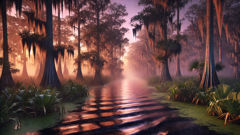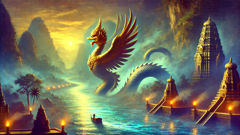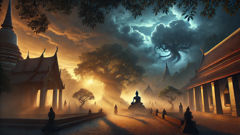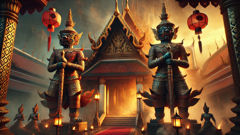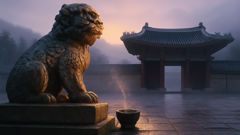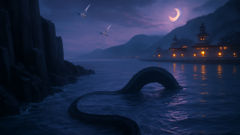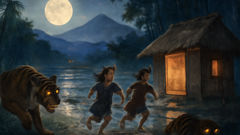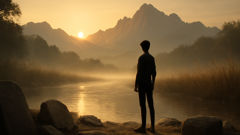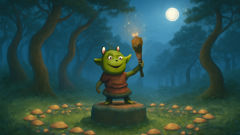Introduction
The sun had just begun to dip beneath the horizon, painting the sky in delicate bands of peach and lavender, while the vast, tangled sprawl of the Florida Everglades came alive with the calls of hidden creatures. Cypress knees jutted like gnarled sentinels from the blackwater slough, and curtains of Spanish moss swayed in the humid air. Somewhere beneath the thicket of sawgrass and palmetto, the water rippled with the unseen stirrings of alligators, turtles, and ancient secrets. In this wild, primeval landscape, the line between myth and reality is as elusive as the mist that coils over the wetlands at dawn. Here, for generations, local fishermen, hunters, and travelers have whispered about a beast both feared and revered—a hulking, hairy figure shrouded in mystery, with eyes that gleam like amber coals and a stench that can empty a campsite in seconds. They call it the Skunk Ape. Some say it’s a cousin to Bigfoot, a reclusive creature that’s managed to remain hidden in one of North America’s last untouched wildernesses. Others insist it’s nothing but a tale spun by moonshiners to scare off nosy strangers. But for those who’ve heard strange howls echoing over the marsh or caught a glimpse of something massive lumbering through the fog, the Skunk Ape is all too real. As the legend has grown, so too has the Everglades’ reputation as a place where the fantastic might step out from the shadows. Our story begins with Owen Carver, a restless wildlife photographer known for chasing stories other people dismiss. Owen’s curiosity has led him across continents, but the rumors of the Skunk Ape have always tugged at the edge of his imagination. Armed with his camera, a battered notebook, and a stubborn belief that there’s truth hidden in every legend, Owen plunges into the swamp, determined to capture the impossible. What he finds will change not only his understanding of the wild, but the way he sees himself—and the delicate balance between humankind and nature that defines the Everglades.
Whispers in the Marsh: Owen’s Arrival
Owen Carver’s boots squelched in the dark muck as he made his way through the sawgrass. The air was thick, pressing in with the scent of earth, decay, and something just a touch more pungent. He had arrived that morning at the edge of the Everglades—arms sunburned, camera gear packed with meticulous care, and a small, handwritten map provided by a local fisherman named Eustace. Eustace had smiled as he’d handed Owen the dog-eared scrap of paper, warning him to keep his wits about him at night.
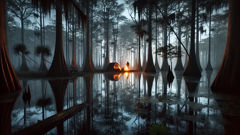
There was a strange sort of peace in the swamp. The constant buzz of insects, the chorus of frogs and distant wails of limpkins, created a living symphony that settled somewhere deep in Owen’s chest. He moved slowly, mindful of the tangled roots beneath his feet and the way the water lapped at the edges of the narrow path. He’d read every article he could find about the Skunk Ape: blurry photos, wild-eyed testimonials, police reports filed with a mix of exasperation and fear. What had always fascinated Owen wasn’t just the creature itself, but the way it had woven itself into local lore—how people spoke of it with a mix of dread and affection, how it seemed to represent something untamed at the heart of the Everglades.
After hours of wading and dodging low-hanging branches, he reached a small clearing. Here, the trees arched overhead like cathedral columns, and shafts of late afternoon sunlight danced on the water’s surface. He paused, breathing deeply, trying to pick up any sound that might be out of place. It was then that he noticed the smell: an overpowering musk, like rotting citrus mixed with wet fur and sulfur. Owen’s heart thudded in his chest. He fumbled for his camera, hands trembling, and scanned the tree line. Something moved—a dark blur, gone before he could focus. The hairs on his neck prickled.
He set up camp as dusk settled in, scribbling in his notebook and replaying what he’d seen—or thought he’d seen. The Everglades have a way of distorting perception. Shadows lengthen and twist; the cries of birds sound like laughter or warnings, depending on your mood. As night fell, Owen sat beside his small fire, listening to the low rumble of thunder in the distance and watching the shifting patterns of fireflies. That night, he dreamed of golden eyes and tangled hair, of massive footprints pressed deep in the mud, and the scent—always the scent—that hovered like a warning at the edge of consciousness.
Tracks, Testimonies, and Tangled Roots
Owen woke before dawn, the memory of his dream still clinging like dew on his skin. The air was cool and damp, filled with the promise of discovery. He shouldered his pack and followed the faint trail through stands of saw palmetto, guided by instinct and the occasional muddy footprint that seemed too large for any bear or boar. As he ventured deeper, the canopy grew denser, filtering sunlight into green-gold shafts that painted everything in ethereal hues.
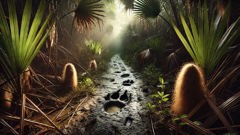
Every so often, he paused to take photographs—delicate wild orchids perched on gnarled branches, a blue heron poised like a statue among the reeds, a pair of alligators sunning themselves on a half-submerged log. Yet Owen’s true focus never wavered. The footprints became fresher, their edges sharp in the soft earth. He crouched to measure one: nearly eighteen inches long, with five toes and deep impressions that suggested immense weight. A shiver of excitement ran through him. He snapped photos and pressed a plastic ruler alongside for scale, just as a branch snapped nearby. Owen froze, his breath hitching.
A voice called out: “You lost, stranger?” It was Eustace, appearing with the stealth of a seasoned trapper. He grinned, revealing a missing tooth, and motioned for Owen to follow. Over coffee brewed on a battered camp stove, Eustace shared his own story—a night years ago when he’d stumbled upon a Skunk Ape rooting through his bait buckets, its eyes reflecting orange in his flashlight beam. “Smelled like a wet dog that rolled in a landfill,” he chuckled, though his hands trembled ever so slightly as he stirred his mug. Owen recorded every detail, hungry for corroboration.
They spent the morning following a fresh trail, finding tufts of coarse hair snagged on brambles and odd claw marks scored into tree trunks at shoulder height. Eustace’s stories grew wilder with each hour, weaving in tales of moonlit dances, eerie howls that made even alligators flee, and vanished livestock. For every claim, Owen tried to anchor himself in evidence, but the boundaries between fact and folklore blurred with each step. By noon, they reached a pond where water lilies floated on a mirror-still surface. Here, they found more prints—and something else: a battered tin lunchbox, its lid pried open and its contents gone. Eustace whistled. “Whatever it is, it’s clever,” he said. “And it’s watching us.”
That night, after Eustace departed, Owen lingered by the water’s edge, camera at the ready. The swamp was alive with sound—the distant bellow of frogs, the shriek of an owl, and underneath it all, something heavier moving through the brush. He caught a glimpse of movement—a shadow slipping between the trees, too swift and deliberate to be a deer. The smell was back, stronger than before. Owen’s heart pounded as he snapped photos into the darkness, knowing full well that he was being watched.
A Face in the Fog: The Skunk Ape Revealed
The next day dawned grey and drizzly, the kind of weather that seems to seep into your bones. Owen moved slowly, exhausted but driven by a restless curiosity. He checked his camera—blurry shapes, streaks of movement, nothing definitive. Yet each frame felt significant, as if the swamp itself was conspiring to keep its secrets just out of reach. He pressed onward, following the trail along a blackwater creek where cypress knees formed ghostly silhouettes in the mist.
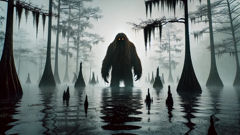
It was near noon when he heard it: a deep, guttural grunt, followed by the unmistakable sound of something massive wading through water. Owen crouched low, his pulse hammering in his ears. The odor hit first—overpowering, rank, almost physical in its intensity. Branches snapped. The reeds parted. And then he saw it.
The creature was easily seven feet tall, covered in matted, dark brown hair streaked with grey and flecks of green moss. Its arms were long, its shoulders impossibly broad, and its face—almost human, but with a protruding brow and deep-set amber eyes that flicked over Owen with wary intelligence. It paused in the shallows, staring back at him. For a long moment, neither moved. The Skunk Ape sniffed the air, its nose wrinkling, and emitted a low, almost mournful sound. Owen’s hands trembled as he raised his camera.
He snapped photo after photo—some clear, others blurred by his shaking hands. The Skunk Ape watched him, then turned and melted into the trees with surprising grace for something so large. Owen stumbled after it, heedless of thorns and mud, but it was gone—swallowed up by the endless maze of the swamp. He collapsed on a fallen log, breathless and elated, unsure if he’d just experienced reality or a fever dream born of obsession and sleeplessness.
As he reviewed his photos, Owen realized that the most compelling image was not of the creature itself, but of its eyes: sad, wise, and tinged with fear. He began to wonder whether he’d been searching for a monster, or for something much more vulnerable—a relic of a wilder world clinging to survival in the last patches of true wilderness. That evening, as thunder rumbled and rain battered his tent, Owen wrote in his notebook: “We are not alone in these wild places. And maybe we never were.”
Conclusion
Owen left the Everglades changed—not just by what he’d seen, but by what he’d felt in the presence of something so ancient and mysterious. The Skunk Ape, he realized, was more than a legend spun by locals or a cryptid to be captured on film. It was a symbol of all that remains untamed in a world rushing toward modernity; a reminder that not every mystery is meant to be solved, and that true wonder lies in accepting the limits of our knowledge. As he shared his story and photographs with the world, debates flared anew: Was the Skunk Ape real, or just another trick of the light and imagination? For Owen, it didn’t matter. The swamps still whispered at dusk, the cypress trees still guarded their secrets, and somewhere out there, a shy giant moved through the shadows—watching, waiting, and reminding us that there’s magic left in the wild places if we dare to look.

